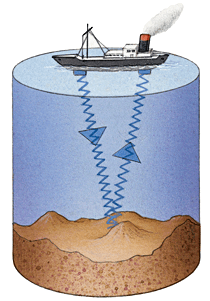DK Science: Ocean Floor
Just a century ago, the ocean floor was largely unknown. Now we know that the deep oceans have features such as mountains, deep valleys, and vast plains. Many of these are formed by the movement of the tectonic plates that make up Earth’s crust. Far below the ocean’s surface, volcanic mountain chains are rising in mid-ocean zones where plates pull apart. Elsewhere, deep trenches descend in subduction zones where plates collide and one dives below the other.

Oceanographers use sonar to map the ocean floor. The research ship directs sound waves at the bottom, and charts the echoes that bounce back to create a detailed map. Sonar has revealed features such as seamounts (submerged volcanic peaks), which rise 1,000 m (3,300 ft) from the sea floor, and guyots (flat-topped seamounts).
In 1977, scientists used submersible vehicles to explore the seabed and discovered vents gushing dark plumes of superhot, mineral-rich water. These black smokers, are caused by volcanic activity at mid-ocean ridges. Water entering cracks in the crust is heated by magma and mixed with mineral sulphides, then belched forth in dark clouds.
Marie Tharp, along with colleague Bruce Heezen, made the first detailed map of the ocean floor using sonar readings. In the late 1940s, Tharp discovered a rift valley running down the centre of the Mid-Atlantic Ridge, and came to realize that a chain of mid-ocean ridges circles the globe.
